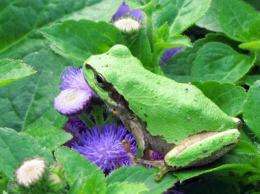Frog calls inspire a new algorithm for wireless networks

Males of the Japanese tree frog have learnt not to use their calls at the same time so that the females can distinguish between them. Scientists at the Polytechnic University of Catalonia have used this form of calling behaviour to create an algorithm that assigns colours to network nodes – an operation that can be applied to developing efficient wireless networks.
How can network nodes be coloured with the least possible number of colours without two consecutive nodes being the same colour? A team of researchers at the Polytechnic University of Catalonia have found a solution to this mathematical problem with the help of some rather special colleagues: Japanese tree frogs (Hyla japonica).
These male amphibians use their calls to attract the female, who can recognise where it comes from and then locate the suitor. The problem arises when two males are too close to one another and they use their call at the same time. The females become confused and are unable to determine the location of the call. Therefore, the males have had to learn how to 'desynchronise' their calls or, in other words, not call at the same time in order for a distinction to be made.
"Since there is no system of central control organising this "desynchronisation", the mechanism may be considered as an example of natural self-organisation," explains Christian Blum. With the help of his colleague Hugo Hernández, such behaviour provided inspiration for "solving the so-called 'graph colouring problem' in an even and distributed way."
A graph is a set of connected nodes. As in the case of the frog's 'desynchronised calls', operating in a 'distributed' fashion implies that there is no other way of central control that helps to solve the problem with a global vision and all the information on the situation.
In the same way, the researchers have devised a new algorithm for assigning colours to network nodes ensuring that each pair of connected nodes is not the same colour. The end goal is to generate a valid solution that uses the least amount of colours.
Application to WiFi connections
As Blum outlines, "this type of graph colouring is the formalisation of a problem that arises in many areas of the real world, such as the optimisation of modern wireless networks with no predetermined structure using techniques for reducing losses in information packages and energy efficiency improvement."
This study falls under the field of 'swarm intelligence', a branch of artificial intelligence that aims to design intelligent systems with multiple agents. This is inspired by the collective behaviour of animal societies such as ant colonies, flocks of birds, shoals of fish and frogs, as in this case.
More information: Hugo Hernández y Christian Blum. "Distributed Graph Coloring: An Approach Based on the Calling Behavior of Japanese Tree Frogs". Swarm Intelligence 6 (2): 117-150, 2012. Doi: 10.1007/s11721-012-0067-2


















